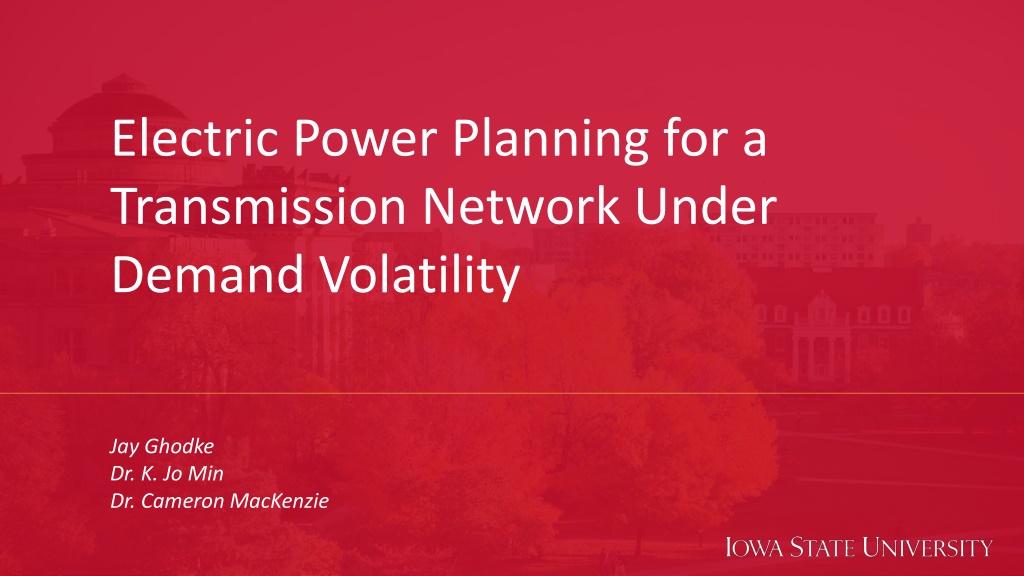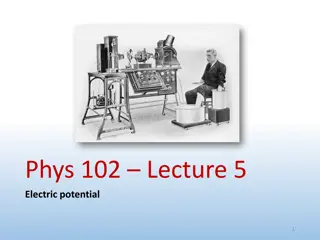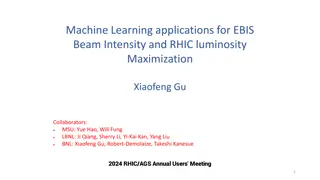Electric Power Network Optimization
Making critical decisions in electric power planning involves balancing supply and demand for efficient transmission network operation. Utilizing Optimal Power Flow (OPF) models and DC approximation, this study explores the impact of generation placement on cost and network performance. By formulating and solving the DCOPF problem using Excel, the analysis compares scenarios with and without specific generators to optimize power flow.
Download Presentation

Please find below an Image/Link to download the presentation.
The content on the website is provided AS IS for your information and personal use only. It may not be sold, licensed, or shared on other websites without obtaining consent from the author.If you encounter any issues during the download, it is possible that the publisher has removed the file from their server.
You are allowed to download the files provided on this website for personal or commercial use, subject to the condition that they are used lawfully. All files are the property of their respective owners.
The content on the website is provided AS IS for your information and personal use only. It may not be sold, licensed, or shared on other websites without obtaining consent from the author.
E N D
Presentation Transcript
Electric Power Planning for a Transmission Network Under Demand Volatility Jay Ghodke Dr. K. Jo Min Dr. Cameron MacKenzie
Introduction Whether to build a new power plant at a community or transmit from another community to meet its demand is a significant decision for generation and transmission planners. Such a decision has a significant consequence on labor and capital requirements as well as the entire transmission network. Optimal Power Flow (OPF) has been widely used in system planning where the goal is to fulfill the customer demand while minimizing the cost. We use DC approximation of the AC network for our model to calculate the OPF.
3 Bus Network Model There are three generators over bus 1, 2 and 3. The marginal cost of generator 1, 2 and 3 is $7.92/MWh $7.85/MWh and $7.97/MWh, respectively. The physical transmission limit of transmission line P12 is 210MW. The demand load at bus 1 is 270 MW, bus 2 is 550 MW and bus 3 is 100 MW, and the total load is 920 MW. Reactance for line 1-2, 1-3 and 2-3 is 0.1 PU, 0.125 PU and 0.2 PU, respectively. We will consider two cases for this model. Case 1 Only G2 and G3 will be present in the network and G1 is non-existent. Case 2 We add G1 in the network. There is no upper bound for the production limit of the generators.
Objectives A three-bus network is designed with 3 demand loads and 3 generators and physical limits on line 1-2 - Use the DCOPF formulation for the 3-bus network to calculate the optimal power flow and LMP Model the OPF problem in Excel. Use excel solver to solve the optimization problem Calculate OPF and LMPs for case 1 where G1 is not present Calculate OPF and LMP for case 2 with G1 in the system and compare with case 1
DCOPF Formulation Mathematical formulation for DCOPF model ??? = marginal cost of generator i ?? = generation at bus i ?? = phase angle for bus i ??? = Power-flow in line i-j ?????? = demand load at bus i Objective Function: minimize (??1 ?1 + ??2 ?2 + ??3 ?3) Decision variables are ?1,?2,?3 and ?1,?2,?3, and ?12, ?13,?23
DCOPF Formulation Subject to following constraints: Nodal power balance constraints: 100 [??]? = ???? ????? Where, ? is in radians and [??] is in per unit. Where, [??] = [??] is the susceptance matrix with ???components and, ?????1 ?????2 ?????3 ?1 ?2 ?3 ?1 ?2 ?3 ??= ?????= ????=
DCOPF Formulation ??? is the susceptance of the branch i to j given by: ??? = ( 1 ??? ); ??? = ( 1 ???+ 1 ???) i.e., the sum of reactance of the lines joining at the bus. ??? = reactance between line i and j Reactance for line 1-2, 1-3 and 2-3 is 0.1 PU, 0.125 PU and 0.2 PU, respectively. Power-flow in each branch: ???= 100 ????? ?? = 100 (?? ??)/( ???) Transmission limit constraints: 100 (?? ??)/??? ?????? 100 (?? ??)/??? ??????
Case 1 2 generators Objective Function will be - minimize (??3 ?3 + ??2 ?2) The total demand on the network will be covered by G2 and G3.
Case 1 Results G2 = 827.5 MW, Cost = 6496.87 $/h G3 = 92. 5 MW, Cost = 737.22 $/h OPF P12 = 210 MW P31 = 60 MW P23 = 67.5 MW Total Production Cost 7233.1 $/h
Case 2 3 generators Objective Function will be - minimize (??1 ?1 + ??2 ?2 + ??3 ?3 ) The total demand on the network will be covered by G1, G2 and G3. Marginal cost of G1 is 7.92 $/MWh.
Case 2 Results G1 = 56.92 MW, Cost = 450.83 $/h G2 = 863.07 MW, Cost = 6775.15 $/h OPF P12 = 210 MW P31 = -3.07 MW P23 = 103.07 MW Total Production Cost 7225.98 $/h
Locational Marginal Price (LMP) Locational Marginal Price at a node in the network is the marginal cost of the generation source to deliver one additional unit of energy LMP is determined considering that at this node energy source is already deployed by a generation source LMP is a method for wholesale electric energy prices to reflect the value of electric energy at different locations, accounting for the patterns of demand, generation, and the physical constraints of the transmission system Prices in LMP-based wholesale power markets vary by location and time and reflect the incremental cost of meeting demand at any location at any point in time
How to calculate LMP When solving the mathematical model of the DCOPF, LMP is given by the Lagrangian multiplier obtained from the optimization problem The Lagrangian multiplier of respective power balance equation is the value of the LMP for that node In our DCOPF example, we use Excel Solver to obtain the LMP Solving the model using simplex LP/ GRG Nonlinear function and setting the decision variables as mentioned in the OPF module, we obtain the DCOPF. The sensitivity report of our model gives us the LMP values as the shadow prices/Lagrangian Multiplier where the Lagrangian multiplier is a dual variable.
Case 1 (2 Generators) Scenario 1: Limit is not reached In case 1, we will consider 2 scenarios. For the first scenario, the load at node 1 is 200 MW Now the total load is 850 MW on the network. After solving the DCOPF, we see that G2 alone meets the whole demand The transmission limit on line 1-2 is not violated 200MW The LMP at all nodes will be MC of G2
Case 1 Scenario 1 Results G2 = 850 MW LMP Bus 1 = Bus 2 = Bus 3 = 7.85 $/h
Case 1 (2 Generators) Scenario 2: Limit is reached In scenario 2, the load at node 1 is increased to 270 MW The transmission limit on line 1-2 is reached before meeting demand at node 1 Hence, G3 will contribute towards the total demand LMP at node 2 will be the MC of G2 since any extra demand at node 2 can be met by G2 Similarly, LMP at node 3 will be the MC of G3 LMP of node 1 will be a combination of G2 and G3 because the load at node 1 is met by both G2 and G3
Case 1 Scenario 2 Results G2 = 827.5 MW G1 = 92.5 MW LMP Bus 1 = 8.045 $/h Bus 2 = 7.85 $/h Bus 3 = 7.97 $/h
Comparison (Case 1) Scenario 1 and Scenario 2 In scenario 1, the total demand in the network was such that the transmission limit was not violated and hence G2 being the least expensive generator was meeting the whole demand The LMP at all nodes is the MC of G2 since G2 is meeting the demand at all the nodes When the load is increased at node 1 in scenario 2, the transmission limit is violated and hence G2 cannot supply enough power to node 1 G3 contributes to the total demand but G3 being the more expensive than G1, the LMP at node 1 and 3 increases
Case 2 (3 Generators) Adding a generator to Bus 1 In case 2, we will consider the third scenario where the load is 270 MW at node 1 and G1 is added to the network The MC of G2 is the least expensive followed by G1 and G2. Hence our goal is use G2 to supply most of the load After solving, G2 and G1 contribute to meet the total demand G1 is introduced due to physical limits Now, the LMP at node 1 will be reduced since the contributing generators are G1 and G2, and G1 has lower MC than G3
Case 2 (3 Generators) Addition in Input Additional Equation in the DCOPF model from Case 1 When G1 is added to the network, the nodal power balance equation for G1 must be included in the DCOPF model i.e., - Nodal power balance 100 [??]? = ??1 ?????1
Case 2 Scenario 3 Results G2 = 863.07 MW G1 = 56.92 MW LMP Bus 1 = 7.92 $/h Bus 2 = 7.85 $/h Bus 3 = 7.89 $/h
Comparison Scenario 2 and Scenario 3 In scenario 2, the transmission limit on line 1-2 causes G3 to come into action to complete the demand Since G3 is more expensive, we introduced G1 at node 1 which less expensive than G3 but more than G1 Adding G1 to the DCOPF model and solving it, we find - the additional amount of power is now given by G1 Now, the LMP at node 1 and node 3 reduces since the MC of G1 is lesser compared to G3 Therefore, the total production cost reduces as well Adding generator 1 to node affects the community at node 1 as well as the node 3 community
Discussion From the DCOPF example it is evident that how the constraints play a vital role in deciding the total cost As the demand increases, the chances of the constraints getting violated increases and hence the production cost increases In such a case, the decision of adding a generator to the system becomes crucial for the network owners This decision can affect not only the community in question but the entire grid Another alternative to overcome congestion would be adding new transmission lines in the network




























